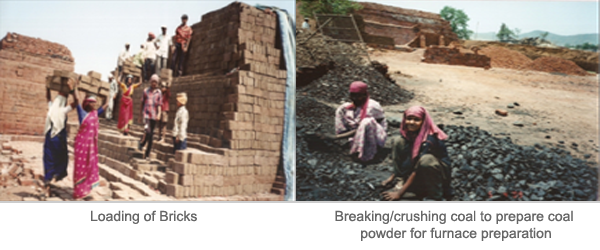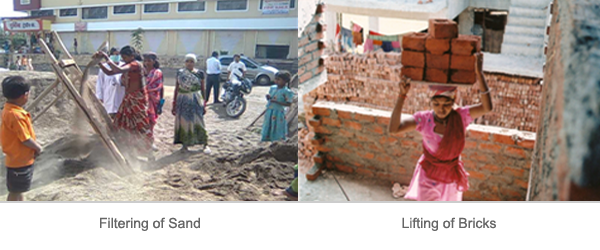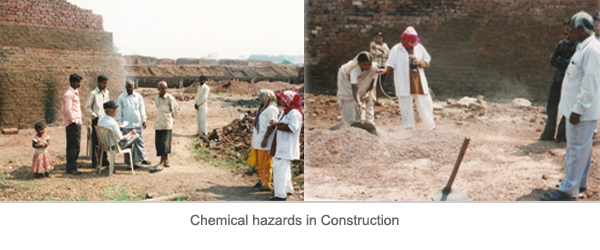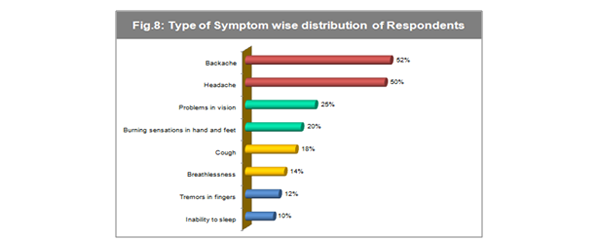Action Oriented Pilot Research Study on Health Status in unorganized sectors (1996-97)
Action Oriented Pilot Research Study aimed at developing a model strategy to provide Occupational Health Service to industrial population employed mainly in unorganized small units and living scattered in slums who form economically and socially weaker sections of the Society Sponsored by: Ministry & Dept of Science and Technology, Govt of India Vide Letter No.: SP/WS/025/86 dated 20/08/1987. The Objectives of the study is to evolve methodology and organization for diagnosis and early detection of existing health problems of the study population and epidemiology of the selected health problems. The trades like Brick kiln (25), stone crushing (22), construction (18) and transport (20) sites covering 2388 workers were offered free medical examination. In total 960 workers were given free treatment and referral services.
Recommendation :
- Mobile ambulatory service strategy- to provide health services at the door step.
- Integration of Comprehensive occupational health services with General Health Service.
- Health Insurance plan
- Literacy classes
- Technological recommendations.
- Low cost protective Kits
- Participatory approach in health care delivery programme
- In-depth research study
- Nutritional guidance & counseling
- Education on child labor
Occupational Health Hazards of working women in unorganized sector (Dec 2008- 2010)
The working area lies amidst the industrial zone of Pimpri Chinchwad Municipal Corporation (PCMC) which has the highest rate of industrial decadal growth leading to migration and mobility, focusing on the plight of unorganized sector especially women. The two unorganized sector covered were brick kiln & construction industry where exposure is mostly form Carbon monoxide & silica dust. Occupational Health Hazards of women in these unorganized sectors may stem from following angles. The women workers are not covered under any factories Acts & management takes advantage of the working people/spot not being inspected by any govt. agencies like the state factory Inspectorate.
-
Health of the working women has to be examined primarily from exposure to working environment coupled with the general medical condition. Accordingly data has been collected of individual working woman from the following angles
- Exposure related symptoms (ES)- primary survey
- Work related symptoms (WRS)
- General Medical symptoms (GRS)
Objective Of The Project :
- To conduct preliminary environmental survey and compile information pertaining to various Environmental/medical studies for different occupational hazards of unorganized sector among women in Pimpri Chinchwad Municipal Corporation (PCMC) in Pune District
- To prepare manuals on safe and healthy work practices for unorganized sector with reference to women working in these sector.
- To conduct workshops on “Occupational Health and Healthy Practices” at the worksites including the employers.
Target Group :
Women working in Brick Kiln & Construction sites.
Construction Sites : Kala Khadak, Wakad, Chikhali, Nigdi, Kharadi, Chakan (total 6 Nos)
Brick Kiln sites : Bodkewadi Phata, Dange chowk & Thergaon, Chikhali, Wakad, Man, Hinjewadi (total 6 Nos)
Brick Kiln sites

Construction Site

Working Environmental Assessment
- Gas sampling: Working environment exposure of gases at brick kilns was determined or measured by gas detector tubes of lowest range of united phosphorous company with the help Gasteck detector pump of model 800.
- Dust Sampling- To measure the Silica dust concentration model SKC Air Check – 52 air sampling instrument was used. Silica dust concentration was measured gravimetrically. Dust concentration in & around brick kiln is very high.
Environmental (chemical hazards) in Brick Kiln

Symptom wise distribution of respondent :
About half of women were complaining backache and headache; 20%-25% were having problems in vision and burning sensations in hand and feet; rest of about 10%-18% women were having symptoms of cough, breathlessness and tremors in fingers etc. Fig- 8

Workshop on ‘Occupational health & safety practices’ for women at Bodkewadi Brick kiln (Participants are Women workers, supervisors, Owners.)

Workshop covers topics pertaining to Introduction , First – aid, fracture, ABC, Ergonomics & Health hazards, Occupational exposure level & personal protective equipments.
Workshop on ‘Occupational health & safety practices’ for women at Wakad Brick kiln (Participants are Women workers, supervisors, Owners.)

Conclusion :
- All the respondents belong to lower income group and majority were illiterate.
- The women workers are migrants and staying in Pune for more than 2-4 yrs
- In two unorganized sectors brick kiln and construction industry younger women work where they do not receive any training related to their work. These women constantly exposed to CO, silica and cement dust at work place as well at residential place. Minimal safety measures were provided by the organization like protective shoes and goggles only in small scale construction industry. This put women more vulnerable to the environmental and work related symptoms which in longer duration led to general medical symptoms.
- Dust concentration in the working environment in winter months is comparable with findings more than the summer months in similar activities, much beyond the TLV. It obviously indicates that use of dust respirator is required in both the seasons. In case of CO gas exposure concentration in summer months is comparable with the concentration in winter months, both above the TLV.
- Physical work related symptoms have led to the required recommendations of work habits with less physical strain. The subtle relationship between the three sets of symptoms viz. ES, WRS & GMS cannot be ignored. Preventive measures for ES were due to higher exposure. Work related stress are, however, to be taken separately for the overall health & wellbeing of working women in these two sectors viz. brick kiln & construction industry.
- In short, regular assessment of the working environment has to be there for ES, using preventive measures (as necessary) through use of personal protection equipment. For WRS, the pattern of work has to be suitably modified as by avoiding excess loading, use of cotton pads on head and shoulder bringing less physical stress/exhaustion.
- For GMS, regular medical examination followed by suitable treatment can help in the general health and well-being of women workers.
